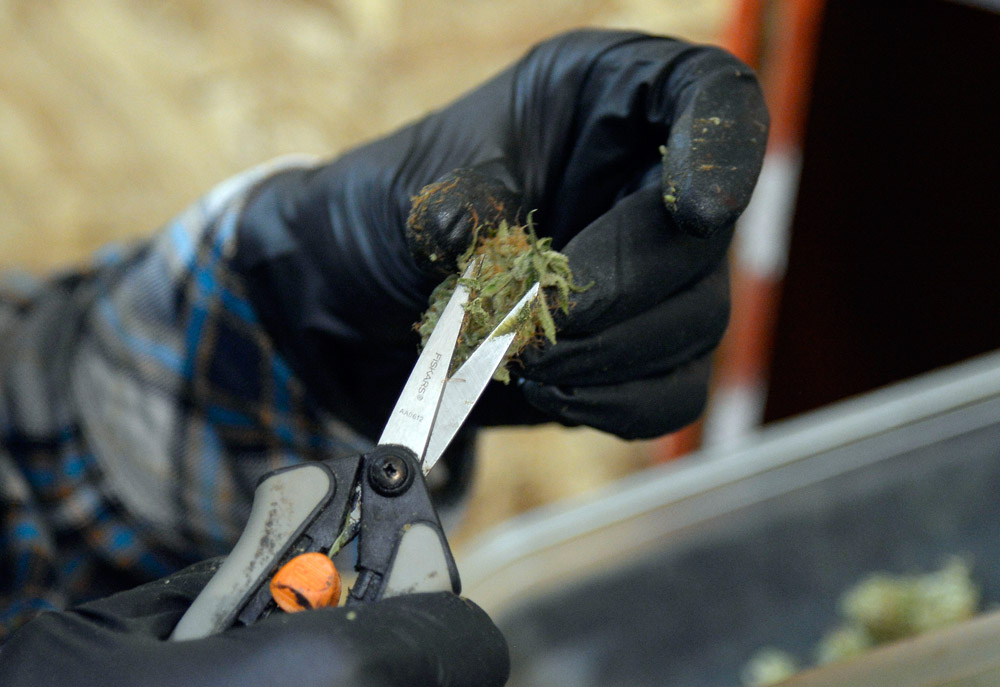On this page: T-V
T
Terpene — The aromatic and flavor compounds found within cannabis (and nearly every other plant on the planet), terpenes are responsible for the veritable rainbow of cannabis strains, which all exhibit subtle differences in smell and flavor. Terpenes are volatile and evaporate at fairly low temperatures, so when storing or extracting cannabis, it is best to keep everything very cold. Terpenes also have medical benefits in themselves, as evidenced by the aromatherapy industry… this means that some of those super flavorful plants that seem to get you higher than the bland ones do actually have a stronger or more rounded effects package.
• “This Lemon G-13 cut has the craziest terpene profile, it is like eating a pile of lemon zest.”
THC — Tetrahydrocannabinol (THC) is the main cannabinoid found in the cannabis plant and is responsible for the majority of the plant’s psychoactive properties. THC has lots of medical benefits including analgesic properties, though perhaps its most defined quality is its tendency to increase appetite. CBD acts as an antagonist to THC, reducing its psychoactive effects.
• “That strain actually tested out at 25.5% THC, it’s one of our most potent varieties.”
Tincture — A liquid extraction of cannabis, often made with alcohol or glycerin, using methods that date back thousands of years. Tinctures are often administered sublingually (or under the tongue) to help with quick absorbtion, offering a similar high to edibles without having to swallow food for those with little appetite. Glycerin tinctures are sweeter, with almost a syrup-like texture, while alcohol tinctures have some serious burn, as they’re often made with high-proof alcohol like Everclear.
• “I always have a little bottle of tincture to help take the edge off.”
Weed Sport: Drops of tincture turn into truth serum at Aqua Golf
Topicals — Topicals are external applications of cannabis that can be used to treat body pain or skin conditions, infused with THC and other cannabinoids. These can include lotions, creams, balms — pretty much anything you can rub on your skin. They generally don’t give you any kind of head or body high, so they’re a favorite of patients that become disoriented when inhaling or otherwise ingesting weed.
• “That weird thing on my leg finally cleared up after I put that topical on it.”
The lowdown on a THC rubdown: I just got a weed-infused massage, and boy, do I feel GREAT
Ladies: Would you use this THC-infused topical oil for heightened orgasms?
Torch — A torch is used to heat up the dabbing surface on a rig. Your local Bed Bath & Beyond has surely seen a major boost in the sales of creme brulee torches since the dabbing scene developed, as these midrange torches are perfect for this use. The bigger propane torches are too hot and can cause oxidation and degradation of titanium and quartz, while the smaller handheld torches don’t have enough flame to fully heat up the nail.
• “I’ve got a dab all queued up, can you pass me the torch?”
Trichome — Holding the majority of the cannabinoid content in the plant, the trichomes are crystalline structures which coat the plant’s bract and leaf surfaces. Looking much like a mushroom when magnified, the head contains the majority of the cannabinoid content and essential oils, but the stalk also has some value; the heads are what is broken off and collected in high-grade dry sieve and water hashes, while the entire trichome is dissolved in solvent-based extracts. There are actually three distinct types of trichomes on the plant: bulbous trichomes are the smallest and not visible to the naked eye, the sessile trichomes are slender and have no head, while the glandular trichomes are the ones that are most often seen and provide the highest amount of cannabinoids.
• “The trichome heads on this Sour Diesel Deep Chunk are huge, I bet it would make amazing melty dry sieve.”

Trim — After harvest, the cannabis plant is generally trimmed of its leaf matter, leaving behind only the buds. Trimming refers to the actual act of removing the leaves, while trim refers to the leftover leaves, which can be used for cooking of extraction. Though trim has less cannabinoid content than buds by weight, it still has quite a lot of good stuff in it. If you are just throwing away or composting your trim instead of using it to make hash, edibles, or tincture, you are missing out on a huge amount of value.
• “I have like ten pounds of trim that I need to turn into water hash.”
Trim run — When concentrates are made from trim rather than buds, they are often known as trim run. Trim run is generally thought to be a step below nug run in terms of yield, potency and flavor, though some concentrate makers report similar results using either type of starting material.
• “This shatter is super tasty for trim run.”
V
Vacuum purge — After extraction, most concentrates require further refining in order to remove the solvent which is remaining in the product. In order to do this, concentrate makers have utilized vacuum ovens and devices which serve to reduce the atmospheric pressure on the concentrate, which speeds up the process of removing the solvent and allows it to happen at a lower temperature than would be possible at normal pressures; this enables more terpene preservation, as they evaporate above certain temperatures.
• “This shatter got a 24-hour vacuum purge and turned out really smooth.”
Vape pen — A small, portable vaporizer that uses either pre-filled concentrate cartridges or has a chamber to load your own concentrates or flower. Vape pens became popular for their discreet, compact design and absence of a traditional “weed” smell when exhaling. They’re used at concerts, sporting events, bars, and pretty much everywhere you can’t just light up a bowl.
• “Hey, it’s halftime. Want to take a pull of the vape pen?”

Whoopi Goldberg: My vape pen and I, a love story (exclusive column written for The Cannabist)
Vaporizer — Rather than combusting your cannabis product (whether it be flowers, hash, or oil), a vaporizer heats it just enough so that the cannabinoids activate, vaporize and can then be inhaled. This method is preferable for those with breathing conditions, or those who simply don’t want to actually smoke anything but still require the direct and immediate relief that inhalation provides compared to edible consumption. A popular variation on the vaporizer that has taken the cannabis (and nicotine) market by storm is the pen vaporizer, also known as an “e-vape”; these are extremely popular due to their small size and high level of discreetness.
• “I have really bad asthma, so I have to use a vaporizer rather than smoking.”
The vaporizer market: Product reviews from O.penVape, Herbalizer, Firefly, VapeXhale, Grenco Science and more. Want your gear reviewed? Submit your glass, vapes and more: cannabistcritics@gmail.com.
Vegetative stage — The part of the cannabis plant’s life cycle where it is actively growing rather than producing flowers. When the plant receives 12 hours of light or greater, it will continue growing vegetatively indefinitely; when the light cycle reaches 12 hours or less, then the plant will begin flowering. During the vegetative stage, the plants prefer a more blue spectrum of light, commonly produced by fluorescent or metal halide (MH) bulbs, whereas flowering plants prefer the more reddish light produced by high-pressure sodium (HPS) lighting.
• “I like to let my plants get big before I flower them, so I leave them in veg state until they get at least 3 feet tall.”
Growing: Want to grow your own weed at home? Some basics
More terminology
A-B | C | D | E-F | G-H | I-J-K | L-M-N | O-P | Q-R | S | T-V | W-Z/Numbers
